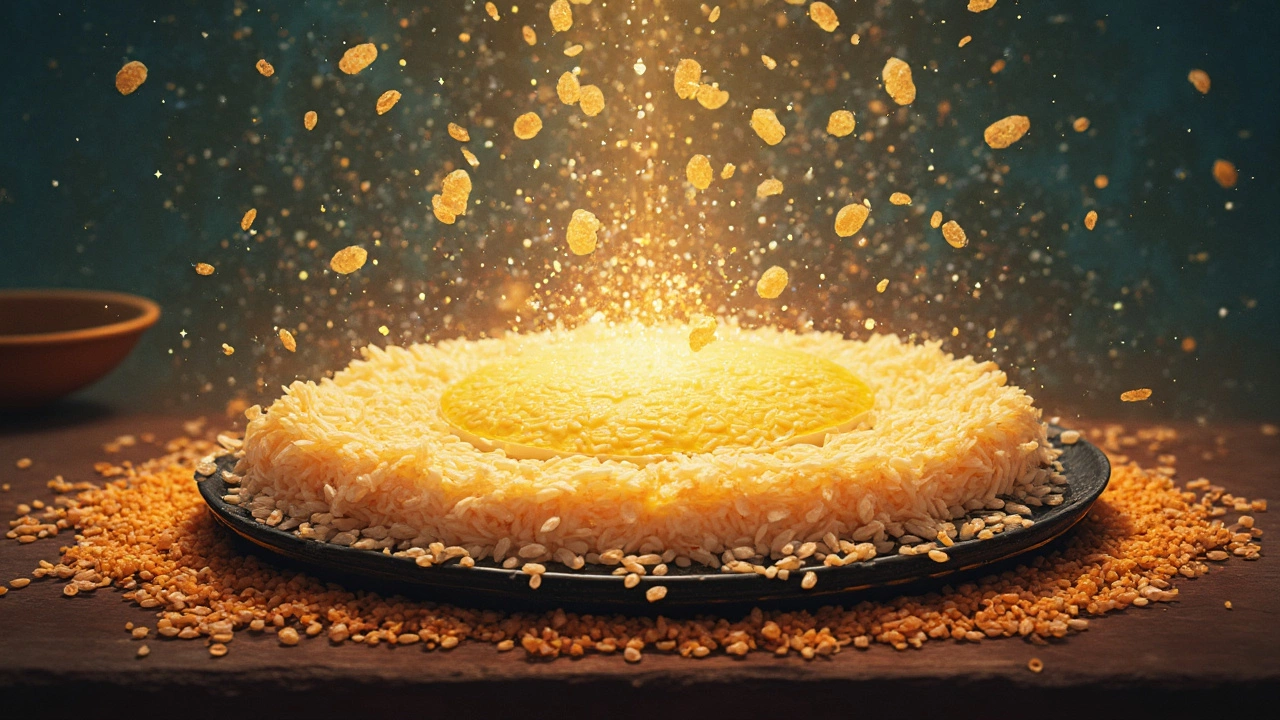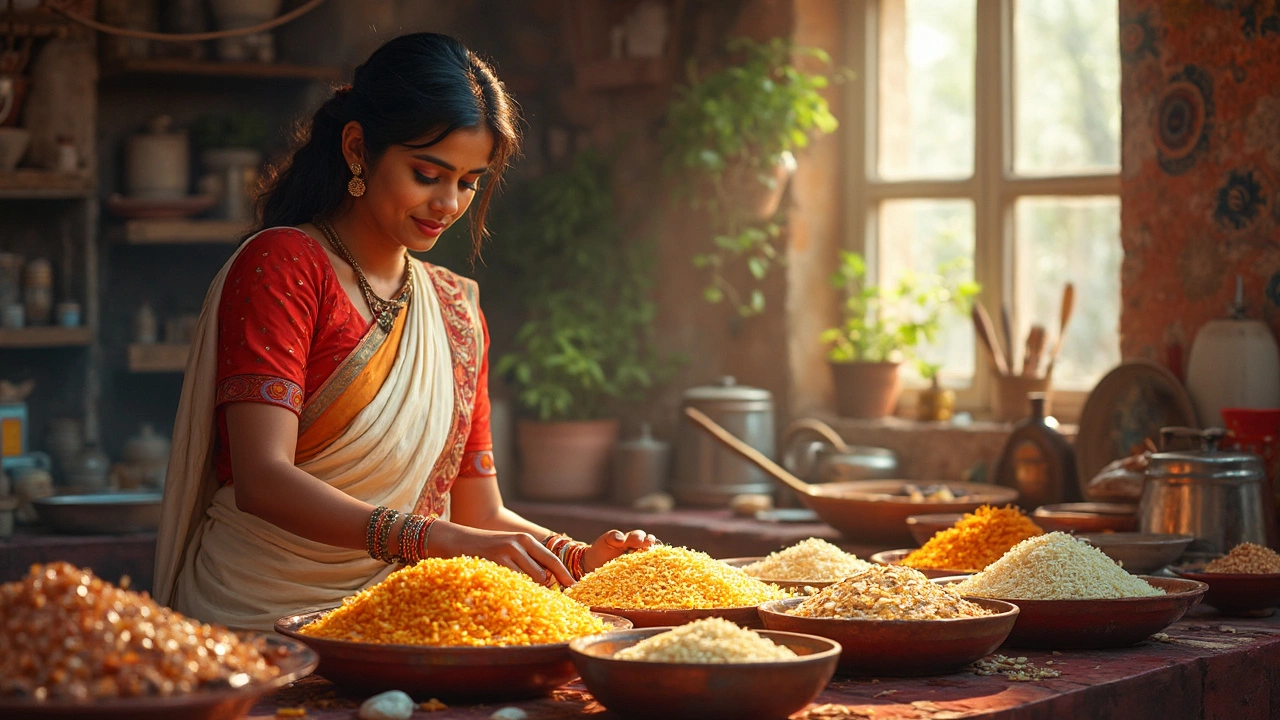If you're living in the USA and craving a nice, crispy dosa, one of the first things you'll grapple with is choosing the right rice for your batter. You might think, 'Isn't all rice the same?' Well, not exactly. Different types of rice can make a world of difference in the texture and taste of your dosa. Let's break it down, shall we?
For starters, dosa is a kind of Indian pancake made from a fermented batter of rice and urad dal (black gram). The type of rice you choose affects the crispiness and the texture of your dosa. In India, short-grain rice like Sona Masoori or Ponni is popular for dosa batter. But depending on where you live in the USA, these might not be as easy to come by.
Don't worry; the USA has plenty of options in store. Whether you're shopping at Whole Foods, the local ethnic market, or even online, choosing the correct kind of rice doesn't have to be daunting. Let's make this delicious journey smoother with some solid rice options!
- Understanding Dosa and its Batter
- Types of Rice Available in the USA
- Best Rice Choices for Dosa Batter
- Tips for Perfect Batter
- Handling Common Dosa Batter Issues
Understanding Dosa and its Batter
Dosa is more than just an Indian pancake; it's a beloved dish packed with flavor and tradition. For those new to this delicacy, dosa originates from the southern part of India but has fans all over the world, especially among folks who've learned the joy of making and eating them.
The foundation of a great dosa lies in its dosa batter. This fermented mixture usually contains two key components: rice and urad dal. The fermentation not only enhances the taste but also contributes to the unique texture of dosa. A well-set batter results in thin, crispy dosas that are perfect for savoring with chutney or sambar.
Why Fermentation Matters
Fermentation is a fascinating process that elevates your batter to the next level. Through fermentation, natural bacteria work to break down sugars in the mixture, making it easier to digest and altering its flavor. This magic is what gives dosas their slight tanginess and iconic texture.
It also introduces a dosage of health benefits, as fermented foods can be good for your gut. For dosa, letting the batter sit for around 8-12 hours at room temperature is usually sufficient.
The Role of Rice
In India, specific varieties like Sona Masoori and Ponni are commonly used to create that perfect dosa batter. These rice types have the right amount of starch to give dosas their crispy finish. But when you're in the USA, you'll need to adapt a bit.
Don't worry, though—you can still get the authentic flavor by choosing from readily available types like Basmati or even Jasmine rice, each bringing its little twist to the taste profiles.
Here's a simple breakdown of the typical dosa batter ingredients:
- Rice: Forms the main structure of the batter
- Urad Dal: Adds a creamy texture and aids fermentation
- Fenugreek Seeds: Optional, but helps in making the dosa crispy
- Water: Key for creating a smooth, consistent batter
Getting the proportions right is crucial, and many swear by a rice-to-dal ratio of 3:1. But feel free to tweak it to suit your personal taste!
Types of Rice Available in the USA
When you're standing in the rice aisle at the grocery store, the sheer variety might overwhelm you, right? But don't worry, we've got you covered. There are several types of rice in the USA that are suitable for making dosa batter, each bringing unique qualities to your beloved Indian crepe.
1. Basmati Rice
Basmati isn't the first choice for dosa back in India, but it’s widely available in the USA and it does the trick. Its long grains provide a slightly different texture but still results in a deliciously crispy dosa. You might want to mix it with other rice types for best results.
2. Jasmine Rice
This fragrant rice can be an interesting option. It has a slightly sticky texture when cooked, which can be favorable when making dosa batter. However, like Basmati, it's best when combined with other types of rice.
3. Sona Masoori
If you're lucky enough to find it, Sona Masoori is a traditional Indian option that works perfectly. It's a medium-grain rice known for its lightweight and aromatic properties, giving you the authentic dosa experience. Finding it might require a visit to an ethnic Indian store or an online purchase.
4. Idli Rice
This rice is specifically intended for southern Indian dishes like idlis and dosas. It's parboiled and might be available at Indian grocery stores. It’s worth a try if you're aiming for authenticity.
5. Parboiled Rice
If Sona Masoori or Idli Rice is elusive, parboiled rice is often used as a substitute. It's partially precooked, which alters its nutritional content but doesn’t compromise the taste.
Here's a handy table summarizing the typical qualities and availability of these rice types in the USA:
| Rice Type | Availability | Best Use |
|---|---|---|
| Basmati | Widely Available | Mix with others for dosa |
| Jasmine | Widely Available | Combine for batter texture |
| Sona Masoori | Ethnic Stores/Online | Authentic dosa |
| Idli Rice | Indian Stores | Traditional dosa/idli |
| Parboiled | Widespread | Alternate for authenticity |
Now that you're armed with these options, go on and pick the rice that suits your cravings and availability. Making dosa in the USA is totally doable with the right rice choice!

Best Rice Choices for Dosa Batter
Alright, so you're standing in the rice aisle, feeling a bit overwhelmed with all those choices. Which one is the best for your dosa batter? Let's make it simple.
In the USA, the best rice options for dosa are those that are similar to the ones traditionally used in India. Look out for dosa rice or Idli rice. These are specially processed and can often be found in Indian grocery stores. If you're lucky, you might even spot them in some larger chain supermarkets.
Sona Masoori Rice
Sona Masoori is a go-to if you're aiming for that authentic texture. Known for its light weight and aroma, it's not only popular in India but also frequently used by Indian families in the USA. This rice balances affordability and flavor, perfect for both beginners and frequent cooks.
Idli Rice
So, what exactly is Idli rice? It's parboiled rice that's specifically meant for batters like dosa. It retains some of its natural starches, contributing to the perfect fermentation needed for soft yet crispy dosas. Keep an eye out for this one, especially if you want a reliable, consistent texture.
Alternatives
If you can't find these specific types, don't sweat it. Jasmine rice, widely available across the USA, can be a decent alternative. Though not identical to traditional Indian varieties, it can still yield decent results. Just make sure to blend it well and give it enough time to ferment.
One cool thing? Recent data suggests that roughly 40% of Indian households in the USA use a mix of Jasmine and regular long-grain rice due to availability and convenience. So, you’re not alone in experimenting!
Remember, the trick is to try different combinations and see what hits the right spot for you. The USA has a wide variety of rice, so you're bound to find something that works perfectly for your homemade dosa batter.
Tips for Perfect Batter
Getting the dosa batter just right can make all the difference between a sad, soggy crepe and a masterpiece of crisp perfection. Let’s dive into some handy tips that will help you nail the perfect dosa batter every time.
Choose Your Ingredients Wisely
The quality and ratio of rice and dal are vital. Stick to a 3:1 ratio of rice to urad dal. This helps achieve the right consistency and ensures your dosa is crispy outside but soft inside. Consider using parboiled rice along with some regular rice for a better texture.
Soaking Essentials
Ensure you soak the rice and dal separately for at least 4 hours. This step helps in grinding them smoothly. Some folks like to throw in a little fenugreek seed or two—this not only aids in fermentation but adds a nice flavor.
Grinding Technique
Once soaked, grind the dal first to a fluffy consistency, then add the rice. Blend until you reach a smooth batter. Don’t forget to add water cautiously. The batter should be thick yet pourable, like a pancake batter.
Fermentation Tips
Fermentation is key. Leave the batter to ferment in a warm place for 8-12 hours. If you're in colder parts of the USA, like Minnesota, try using the oven light or even a heating pad set on low to give the fermenting batter some warmth.
Handling After Fermentation
After fermentation, the batter will have risen and become slightly tangy. Stir it gently. Before cooking, adjust the salt and add a little water if it’s too thick. Don’t stir it too much as this can release trapped air bubbles.
| Step | Time |
|---|---|
| Soaking | 4 hours |
| Fermentation | 8-12 hours |
| Total Prep Time | 12-16 hours |
Now you're ready to ladle that onto your hot pan and let the magic happen. With these tips, you’re well on your way to making dosas just as good as, if not better than, your local Indian restaurant. Enjoy the process, and more importantly, enjoy your delicious dosas!

Handling Common Dosa Batter Issues
So, you've soaked, blended, and fermented your dosa batter, but things aren't quite right. Don't worry; you're not alone. Let's troubleshoot some of the most common dosa batter issues and get them sorted out!
Fermentation Flop
The success of a good dosa largely depends on how well the batter ferments. If your batter isn't rising or getting that slight sour smell, it might be the climate. Dosa batter loves warm places, so if it's too cold, just pop it into a warm oven (turned off, but lights on) or near a sunny window. A little salt during fermentation can help too.
Too Thin or Thick Batter
If your dosa is either not spreading or sticking too much, you might be dealing with batter consistency issues. For a perfect dosa, the batter should be like pancake batter—not too thick, not too thin. If it's too thick, add a splash of water. If it's watery, add some more ground rice or dal.
Sticky Situations
Sometimes, the dosa might stick to the pan. This often happens if the pan isn't hot enough or seasoned well. It's crucial to use a non-stick or well-seasoned cast iron pan. To check if the pan's hot enough, sprinkle a few drops of water—they should sizzle and evaporate right away.
Color Conundrums
Your dosa should ideally be golden brown. If it's turning pale or too dark, play around with your heat settings. A moderate, steady heat gives the best results. Also, make sure your batter is well mixed. Sometimes the rice and dal layers separate, leading to uneven coloring.
Tackling Troubles with Rice Types
Using the wrong rice for dosa can cause chaos. If you're experimenting with different rice types in the USA, note that polished rice might need more soaking time. Mixing in a bit of flattened rice (poha) can also improve the texture and taste.
| Common Issue | Potential Solution |
|---|---|
| Not Fermenting | Use warm settings; add salt |
| Too Thick | Add water to the batter |
| Sticking | Ensure pan is hot and seasoned |
| Pale Dosa | Maintain a moderate heat level |
With these tips, your dosa batter issues should be a thing of the past. Just remember, dosa making is as much an art as it is a science. Each batch teaches something new. Happy cooking!
